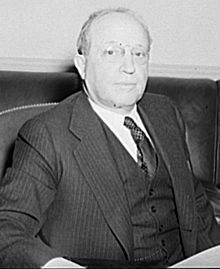Name Eugene Meyer Role Financier | Nationality American | |
 | ||
President Herbert HooverFranklin D. Roosevelt Full Name Eugene Isaac Meyer Died July 17, 1959, Washington, D.C., United States Spouse Agnes Ernst Meyer (m. 1910) Children Katharine Graham, Florence Meyer Parents Marc Eugene Meyer, Harriet Newmark Similar People | ||
Siblings Florence Meyer Blumenthal | ||
Eugene Isaac Meyer (October 31, 1875 – July 17, 1959) was an American financier, public official, and newspaper publisher. He was the publisher of the Washington Post newspaper. He served as Chairman of the Federal Reserve from 1930 to 1933. He also served as the first President of the World Bank Group. He was the father of publisher Katharine Graham and portrait photographer Florence Meyer.
Contents
Life and career
Born in Los Angeles, California, he was one of eight children of Marc Eugene Meyer and Harriet Newmark. His parents were Alsatian Jews, but he avoided identification as a Jew until later in life. He grew up in San Francisco and attended college across the bay at the University of California, Berkeley, but he dropped out after one year and later enrolled at Yale University. He received his A.B. in 1895.
After college, Meyer went to work for Lazard Freres, where his father was a partner, but quit in 1901 after four years and went out on his own. He was a successful investor and speculator and owned a seat on the New York Stock Exchange. He married Agnes Elizabeth Ernst, a Lutheran, in 1910; they had five children, including the future Katharine Graham and another daughter Florence Meyer (1911–1962) (Mrs. Oskar Homolka). By 1915, when he was forty, he was worth $40 million.
In 1920, Meyer teamed with William H. Nichols of General Chemical to help fulfill his vision of a bigger, better chemical company. Meyer and Nichols combined five smaller chemical companies to create the Allied Chemical & Dye Corporation, which later became Allied Chemical Corp., and eventually became part of AlliedSignal, the forerunner of Honeywell’s specialty materials business. Both men have buildings named after them at Honeywell’s headquarters in Morristown, New Jersey.
Meyer went to Washington, D.C. during World War I as a "dollar a year man" for Woodrow Wilson, becoming the head of the War Finance Corporation and served there long after the end of hostilities. President Calvin Coolidge named him as chairman of the Federal Farm Loan Board in 1927 and Herbert Hoover promoted him to chairman of the Board of Governors of the Federal Reserve System in 1930. He served in that capacity from September 16, 1930, to May 10, 1933.
Meyer strongly supported government relief to combat the Great Depression, taking on an additional post as chief of the Reconstruction Finance Corporation, Hoover's unsuccessful attempt to aid companies by providing loans to businesses. After Franklin D. Roosevelt's inauguration in 1933, he resigned his government posts. Meyer has been criticized for not being bold enough in attacking the economic catastrophe of the early 1930s with monetary stimulus and allowing the banking crisis to get out of hand, which deepened the economic collapse.
Purchase of the Washington Post
In June 1933, he bought the Washington Post at a bankruptcy auction, for $825,000, the paper having been ruined by its spendthrift socialite owner, Ned McLean. In his statement to the press, Meyer vowed to improve the Post, and asserted that he would operate it independently. He also said that he had bought the Post on his own, without the influence of "any group or organization." He made this statement to contradict the rumors that as a well-known Republican, he would soon turn it into a voice for Republican causes. Press reaction to the purchase was positive, with other newspapers being pleased that the Post would not go out of business, and would continue to report the news from the Nation's Capital; given its important location, said one editorial, rescuing the Post was "a public service." An editorial in a newspaper that was identifiably Republican praised the purchase as "good news for journalism." While expressing the hope that Meyer would in fact take the Republican point of view, the editorial acknowledged that he probably would not do so, since he seemed to be "no slavish supporter of any party or leader," assuring that under his leadership the Washington Post would be "hard hitting and independent, a paper that nobody can ignore." As it turned out, Meyer did take the side of the Republican party on some issues: for example, he was opposed to Roosevelt's New Deal, and his newspaper often took an anti-New Deal editorial stance.
Over the next twenty years, Meyer spent millions of dollars of his own money to keep the money-losing paper in business, while focusing on improving its quality; by the 1950s, it was finally consistently profitable and was increasingly recognized for good reporting and important editorials. As publisher, Meyer occasionally contributed to stories: his friendship with the British Ambassador, Lord Lothian, led to a Washington Post scoop on reporting of Edward VIII's relationship with Wallis Simpson.
After World War II, Harry S. Truman named Meyer, then 70 years old, to be the first head of the World Bank in June 1946. Meyer appointed his son-in-law, Phil Graham, as publisher. After six months with the World Bank, Meyer returned to the Post, serving as chairman of the Washington Post Company until his death in Washington in 1959.
Meyer's older sister, Florence Meyer Blumenthal, was noted for the philanthropic organization she formed, the Franco-American Florence Blumenthal Foundation, which awarded the Prix Blumenthal to painters, sculptors, decorators, engravers, writers, and musicians.
Honors
Eugene Meyer Elementary School in Washington, DC was named in his honor in 1963. It closed in 2008 and the building has been used as swing space by the school system ever since.
